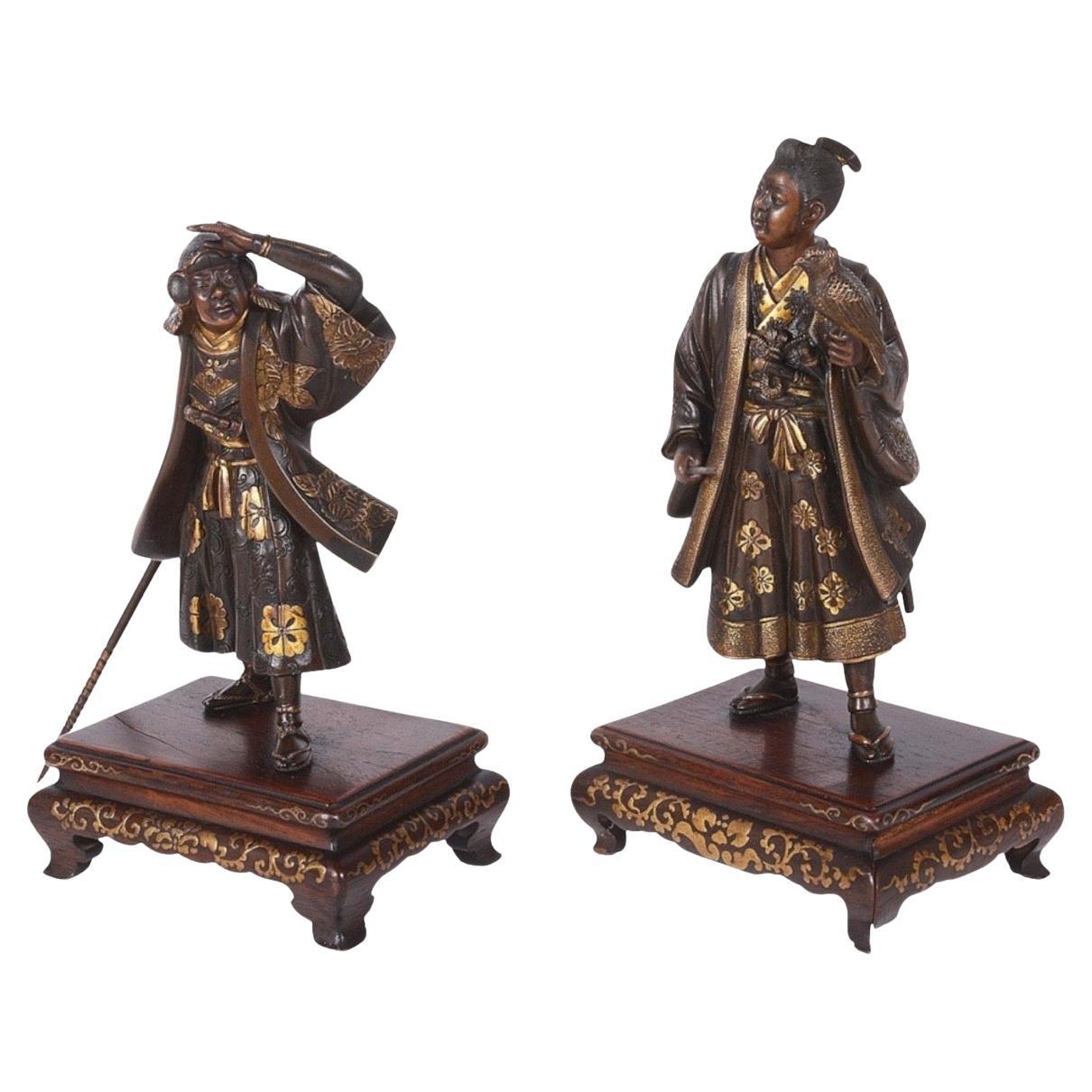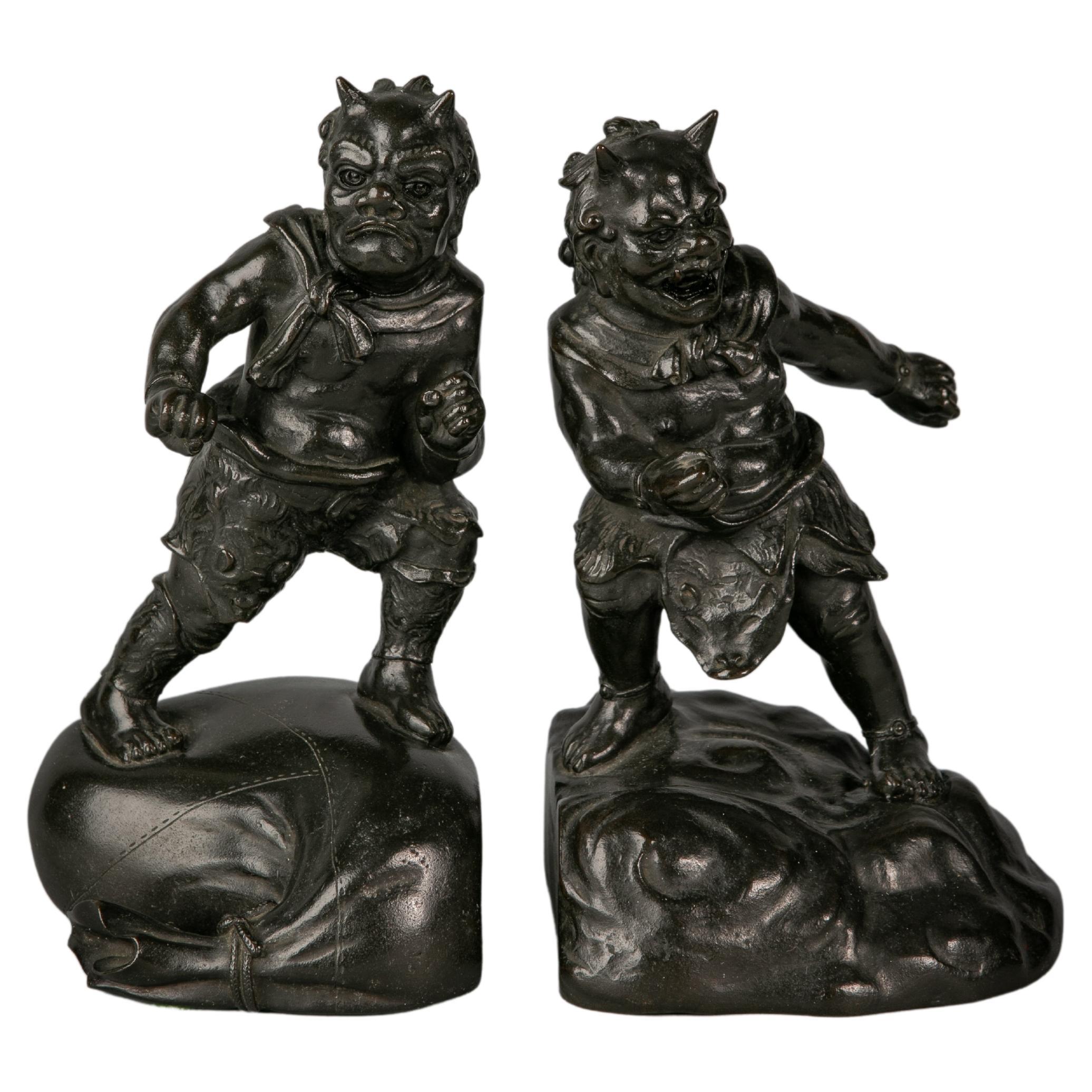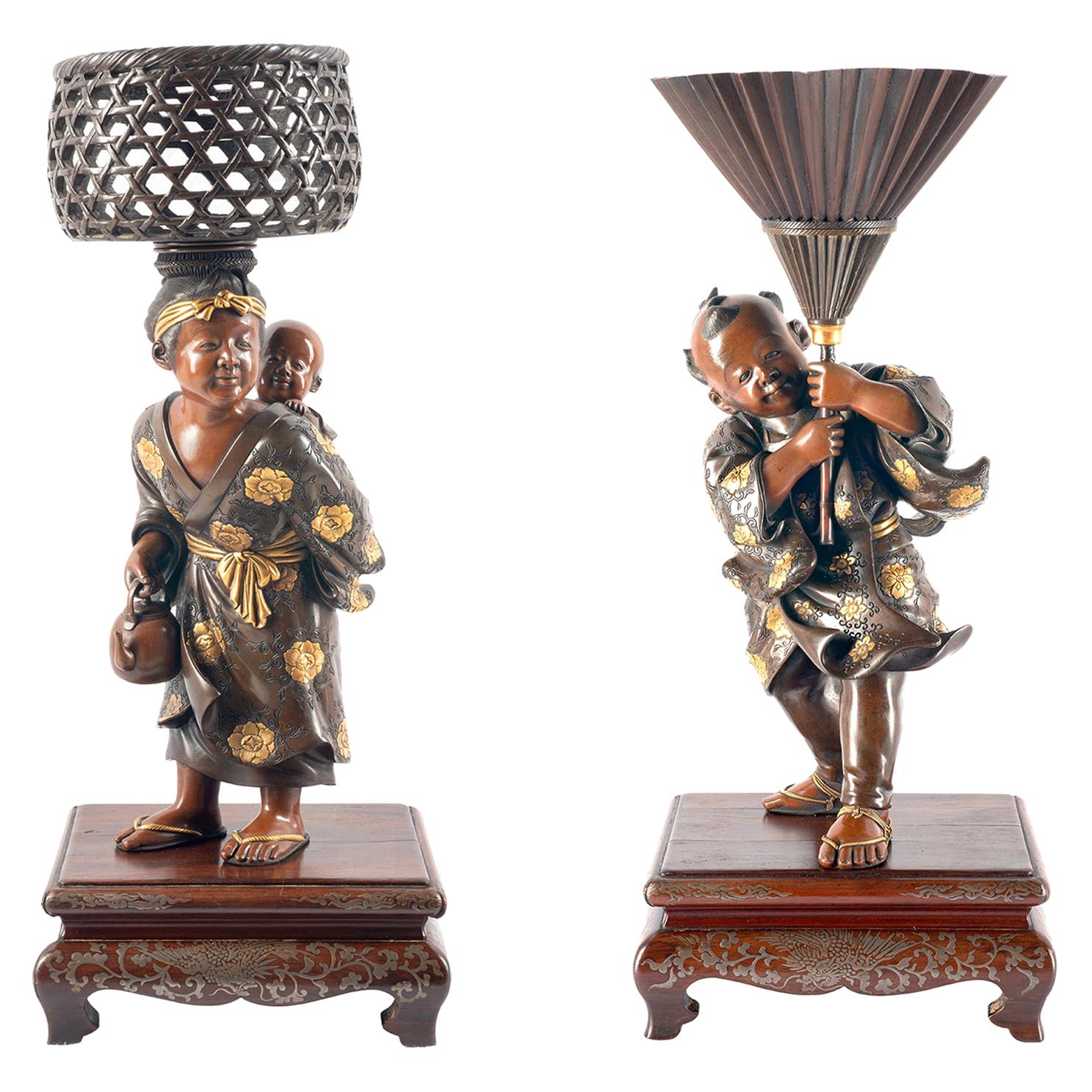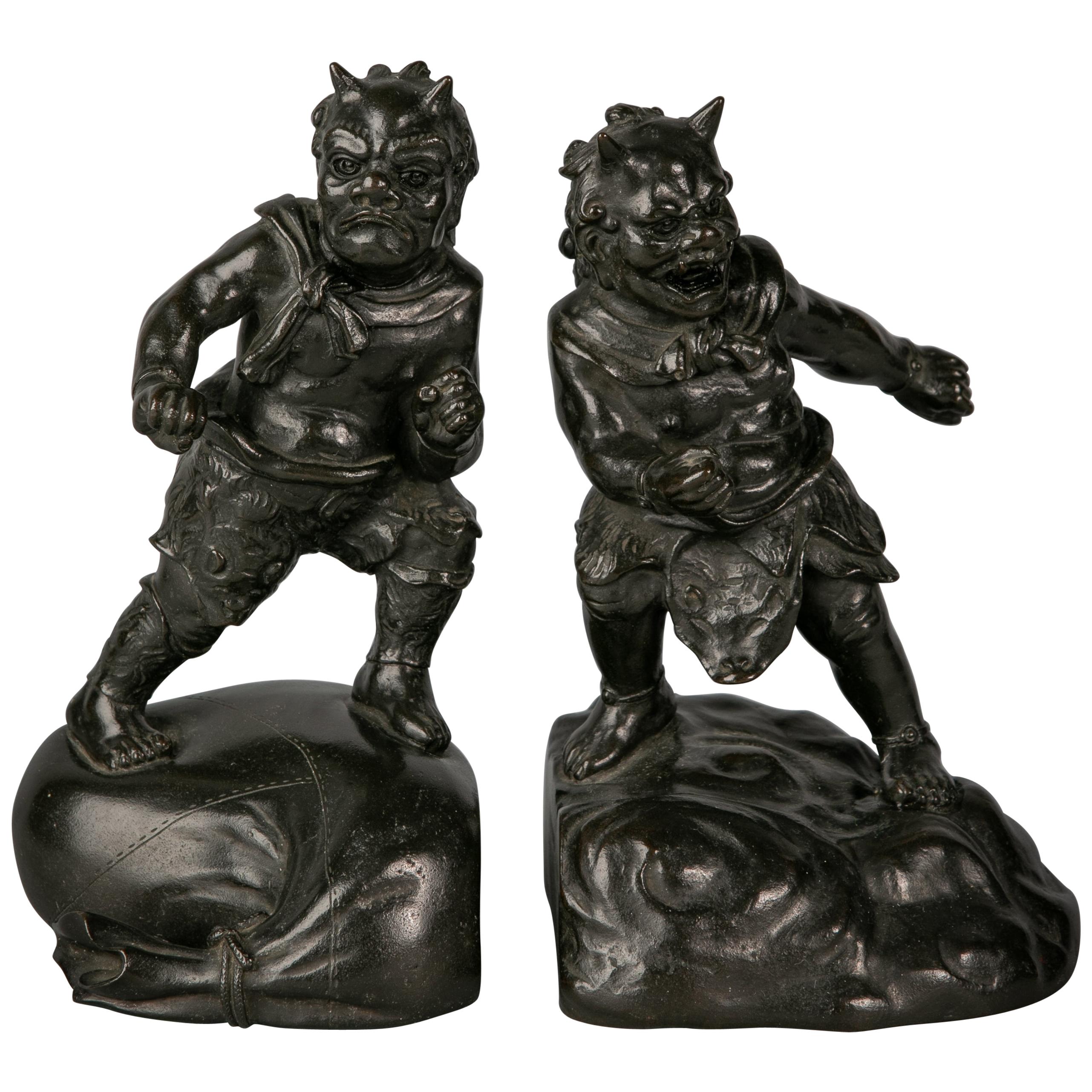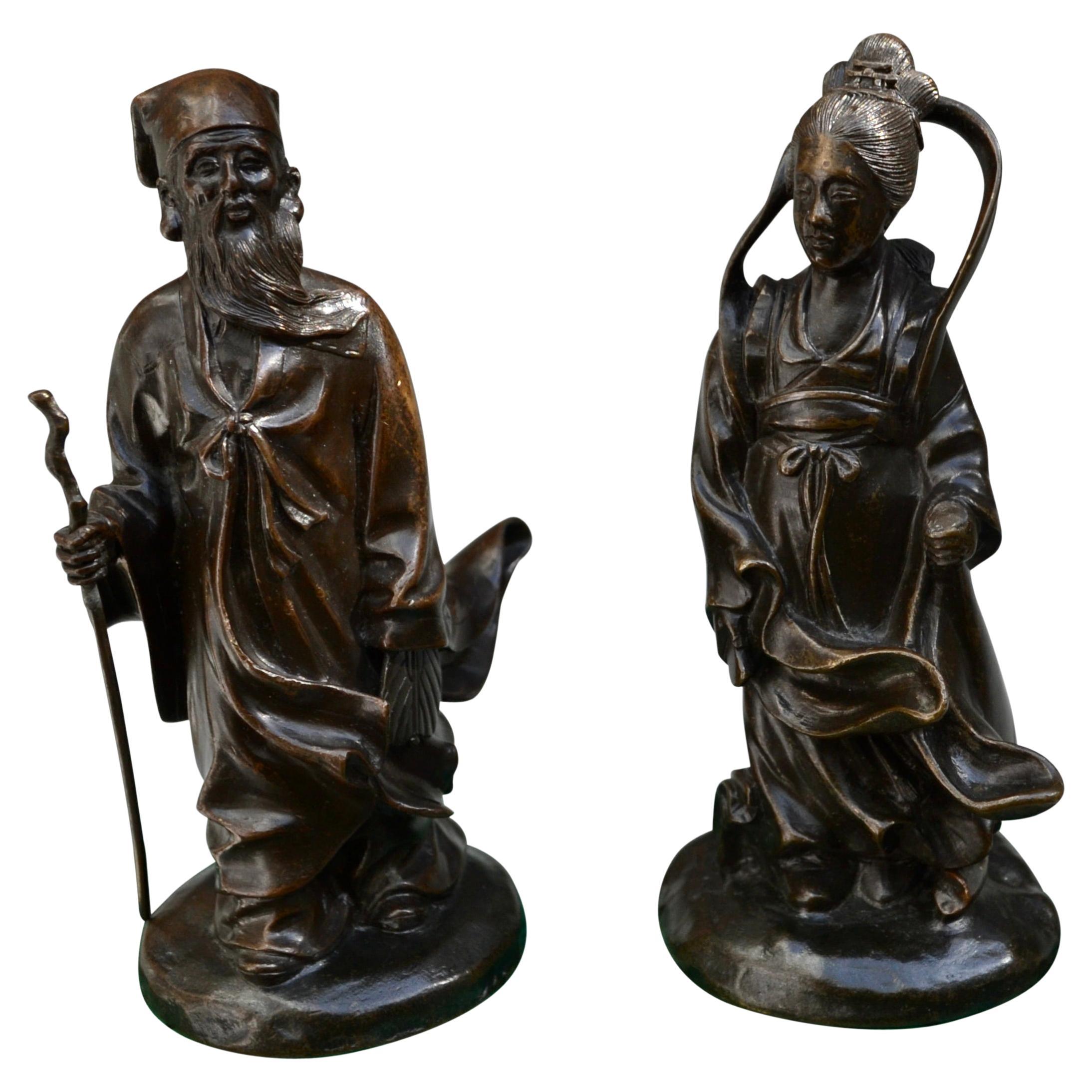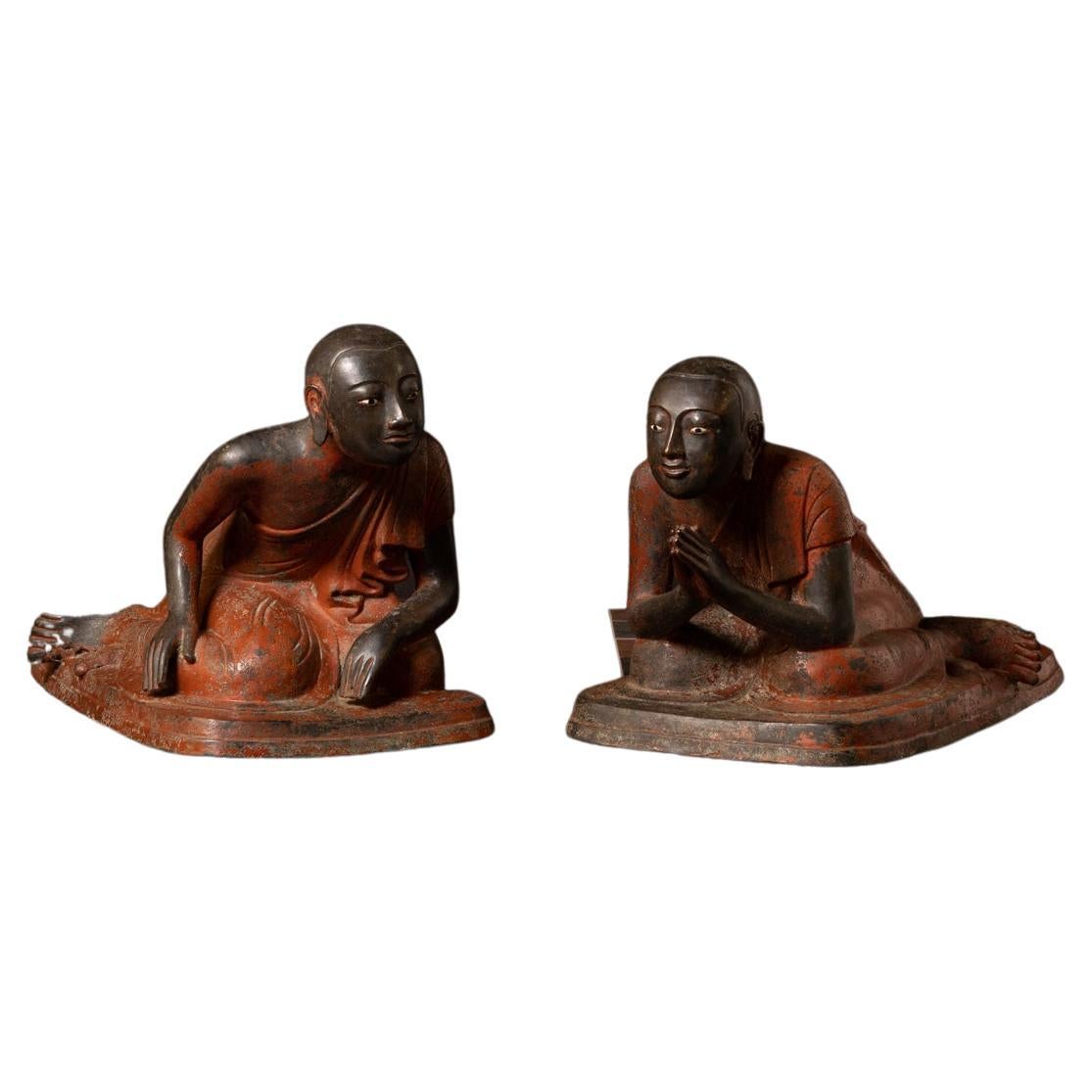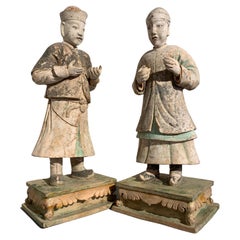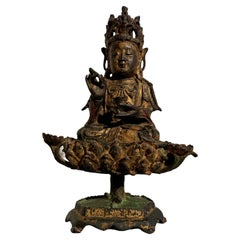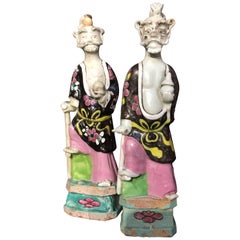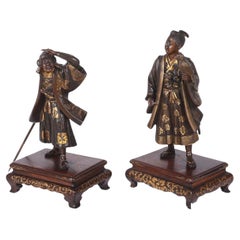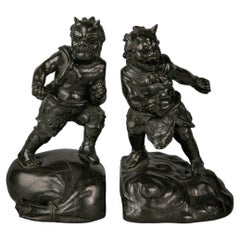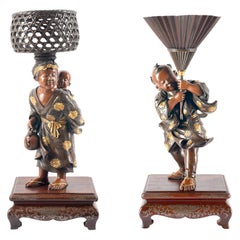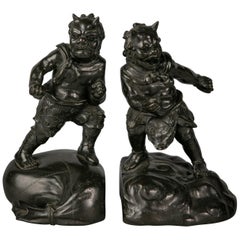Items Similar to Pair of Japanese Cast Bronze Figures of Niō, Meiji Period, Late 19th Century
Want more images or videos?
Request additional images or videos from the seller
1 of 18
Pair of Japanese Cast Bronze Figures of Niō, Meiji Period, Late 19th Century
$1,750per set
£1,329.27per set
€1,531.77per set
CA$2,464.43per set
A$2,732.19per set
CHF 1,435.87per set
MX$33,437.51per set
NOK 17,932.58per set
SEK 16,831.52per set
DKK 11,433.69per set
About the Item
A well cast pair of Japanese mixed metal okimono figures of Buddhist guardians, known as Nio or Dharmapala, protectors of Buddhist faith, Meiji Period, Japan.
The smiling bronze guardian figures cast with a wonderful sense of power and motion. They stand upon raised platforms cast with a wood grain design. The muscular figures are dressed in loose and flowing dhoti, chests bare, scarves billowing outwards.
One has his mouth open, speaking the seed syllable "A", the other with his mouth closed, uttering the seed syllable "Un". Between the two, they encompass all of creation, the beginning and end, life and death (similar to the concept of the Alpha and Omega).
They wear the jewelry of bodhisattvas, including bracelets and anklets, their long hair tied up and held in place by a diadem. Each guardian holds one hand up grasping a half vajra. The Nio are accompanied by rats, often seen as a symbol of wealth and plenty.
A bell would originally have been attached to the half vajras, forming a candle holder. The bells now lost on both figures.
One figure with discoloration to the bronze in some areas. Please see photos for details.
- Dimensions:Height: 9 in (22.86 cm)Width: 4.5 in (11.43 cm)Depth: 4 in (10.16 cm)
- Sold As:Set of 2
- Style:Meiji (Of the Period)
- Materials and Techniques:Bronze,Cast
- Place of Origin:
- Period:
- Date of Manufacture:circa 1880
- Condition:Wear consistent with age and use. Minor fading. Missing the bell cups. One figure with some discoloration to the bronze, as seen in photos.
- Seller Location:Austin, TX
- Reference Number:1stDibs: LU894713508002
About the Seller
5.0
Gold Seller
Premium sellers maintaining a 4.3+ rating and 24-hour response times
Established in 2001
1stDibs seller since 2010
347 sales on 1stDibs
Typical response time: 1 hour
- ShippingRetrieving quote...Shipping from: Austin, TX
- Return Policy
Authenticity Guarantee
In the unlikely event there’s an issue with an item’s authenticity, contact us within 1 year for a full refund. DetailsMoney-Back Guarantee
If your item is not as described, is damaged in transit, or does not arrive, contact us within 7 days for a full refund. Details24-Hour Cancellation
You have a 24-hour grace period in which to reconsider your purchase, with no questions asked.Vetted Professional Sellers
Our world-class sellers must adhere to strict standards for service and quality, maintaining the integrity of our listings.Price-Match Guarantee
If you find that a seller listed the same item for a lower price elsewhere, we’ll match it.Trusted Global Delivery
Our best-in-class carrier network provides specialized shipping options worldwide, including custom delivery.More From This Seller
View AllPair Large Chinese Ming Dynasty Glazed and Painted Pottery Figures, 16th Century
Located in Austin, TX
A striking pair of large Chinese glazed and painted pottery figures, Ming Dynasty (1368 to 1644), circa 16th century, China.
The impressive and realistically modeled figures each portrayed standing upright upon a sancai (three color) glazed pedestal of kang table form.
The man is dressed in a short black surcoat over a long robe and pants, a smart cap upon his head. His face is warm and welcoming, with wide eyes and a slight smile on his lips. He holds his hands out in front of him, palms up, almost as if shrugging, though presumably originally holding an object or offering, now lost.
The woman of slightly smaller stature, and dressed in a longer surcoat over a long robe and skirt. She wears a fitted cap upon her head. Her hands also held out in front, grasping long lost objects. Her face is slightly more severe, with a somewhat pinched look, and slight frown upon her lips.
The size of these figures is remarkable, as is the realism and attention to detail, almost as if they were modeled after real people, as opposed to the more common and generic Ming Dynasty pottery...
Category
Antique 16th Century Chinese Ming Sculptures and Carvings
Materials
Pottery
Chinese Ming Dynasty Bronze Nanhai Guanyin, 16th/17th Century, China
Located in Austin, TX
A decidingly charming Chinese polychromed and gilt cast bronze figure of Nanhai Guanyin, Guanyin of the South Sea, Ming Dynasty, 16th/17th century, China.
Guanyin, the bodhisattva of compassion, is portrayed here as a beatific figure seated upon a raised lotus pedestal over waves. Guanyin is dressed in heavy robes, and wears an elaborate headdress. The small figure of Amitabha Buddha in the headdress positively identifies this figure as Guanyin.
Guanyin rests one hand in his lap, holding a cup of pure water said to be able to alleviate all suffering. His other hand is raised, holding a willow branch which is used to sprinkle the healing waters.
The two lotus blossoms to either side of Guanyin would originally have supported figures of the acolytes...
Category
Antique Early 1600s Chinese Ming Sculptures and Carvings
Materials
Bronze
Pair Chinese Export Famille Rose Figures of Immortals, 18th Century, China
Located in Austin, TX
A near pair of Chinese export porcelain figures of the Taoist immortal Li Tieguai, Qing Dynasty, late 18th century, China.
The Daoist Immortal Li Tieguai, on of the Eight Immortals...
Category
Antique Late 18th Century Chinese Chinese Export Ceramics
Materials
Porcelain
Pair of Japanese Gilt Bronze Komainu by Ishikawa Komei, Meiji Period
Located in Austin, TX
A striking pair of Japanese gilt bronze komainu by the renowned Japanese sculptor, Ishikawa Komei (1852-1913), Meiji period, Japan.
The pair well cast, and robustly modeled. They ar...
Category
Antique Late 19th Century Japanese Meiji Sculptures and Carvings
Materials
Bronze
Pair Japanese Bronze Pagoda Temple Lanterns, Taisho Period, circa 1920, Japan
Located in Austin, TX
An elegant pair of Japanese cast and lacquered bronze pagoda lanterns, Taisho Period, circa 1920, Japan.
The lanterns a true pair, with mirrored decorations and lantern doors opening in opposite directions. The lanterns of traditional toro form, cast in bronze, and lacquered. Each lantern comprised of three parts - the "roof", the "fire box", and the pedestal. This type of pedestal lantern is called a dai-doro, as opposed to the hanging lantern type, tsuri-doro.
The hexagonal roof of the lantern, reminiscent of temples or pagodas, features a wonderful, dense cloud pattern with three heart-shaped cutouts, known as inome, or boar's eye. The roof topped by a hoju, the Buddhist flaming Jewel of Wisdom. Each of the six corners feature a fantastic shachihoko, mythical beasts with the face of a tiger and body of a fish. Bells are suspended from the shachihoko.
The globular body of the lantern features four pierced panels with the three leaf hollyhock mon of the Tokugawa clan surrounded by a karakusa pattern of scrolling vines. One panel serving as a hinged door with a lock stylized as the Three Jewels...
Category
Vintage 1920s Japanese Taisho Lanterns
Materials
Bronze
Pair of Japanese Edo Period Musha Ningyo Courtier Dolls
Located in Austin, TX
Two exquisite Japanese musha ningyo dolls, crafted as courtiers, Edo Period, early 19th century, Japan.
The older man can be identified as the h...
Category
Antique Early 19th Century Japanese Edo Sculptures and Carvings
Materials
Shell, Brocade, Silk, Glass, Wood, Paint, Paper
You May Also Like
A pair of Japanese Miyao Bronze Statues of a Falconer and warrior, Meiji period.
By Eisuke Miyao 1
Located in Brighton, Sussex
A fine quality pair of 19th century Japanese Miyao bronze statues of a Falconer and Sumo warrior in patinated bronze with gold leaf highlights. Mounted on...
Category
Antique Late 19th Century Japanese Figurative Sculptures
Materials
Bronze
Pair of Japanese Bronze Bookends, circa 1880
Located in New York, NY
Pair of Japanese Bronze Bookends, circa 1880
Category
Antique 1880s Japanese Figurative Sculptures
Materials
Bronze
Pair of Japanese Miyao Bronze Figures
By Zo Miyao 1
Located in Brighton, Sussex
A fine quality pair of Japanese Meiji period (1868-1912) Miyao bronze figures depicting a mother carrying her child with a wicker basket on her head, carr...
Category
Antique Late 19th Century Japanese Figurative Sculptures
Materials
Bronze
$41,091 / set
Pair of Japanese Bronze Bookends, circa 1880
Located in New York, NY
Pair of Japanese bronze bookends, circa 1880.
Category
Antique 1880s Japanese Figurative Sculptures
Materials
Bronze
A Pair of Small 19 Century Chinese Patinated Bronze Statues of Gods or Deities
Located in Vancouver, British Columbia
A pair of exceptional small patinated bronze castings of a male and female Chinese Deities or Gods possibly representing Shouxing God of Longevity Immortality and Good Fortune, and G...
Category
Antique Early 19th Century Chinese Ming Figurative Sculptures
Materials
Bronze
19th century very special pair of antique bronze Monk statues from Burma
Located in DEVENTER, NL
Elevate your space with the captivating presence of this very large and special pair of antique bronze Monk statues. Crafted from high-quality bronze, thes...
Category
Antique 19th Century Burmese Sculptures and Carvings
Materials
Bronze
More Ways To Browse
Antique Cast Bells
Japanese Metal Sculpture
Meiji Figure
Japanese Wood Figure
Japanese Buddhist Sculpture
Japanese Meiji Carving
19th Century Japanese Chest
Meiji Bronze Sculptures
19th Century Japanese Wood Carving
Meiji Wood Sculpture
Japanese Bronze Figure
Chest On Metal Stand
Gold And Wood Bracelets
Antique Diadem
Japanese Okimono
Japan Bell
Gold Anklet
Bodhisattva Wood
